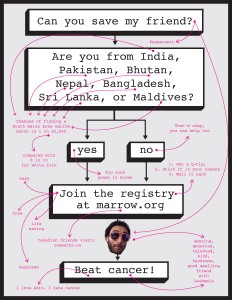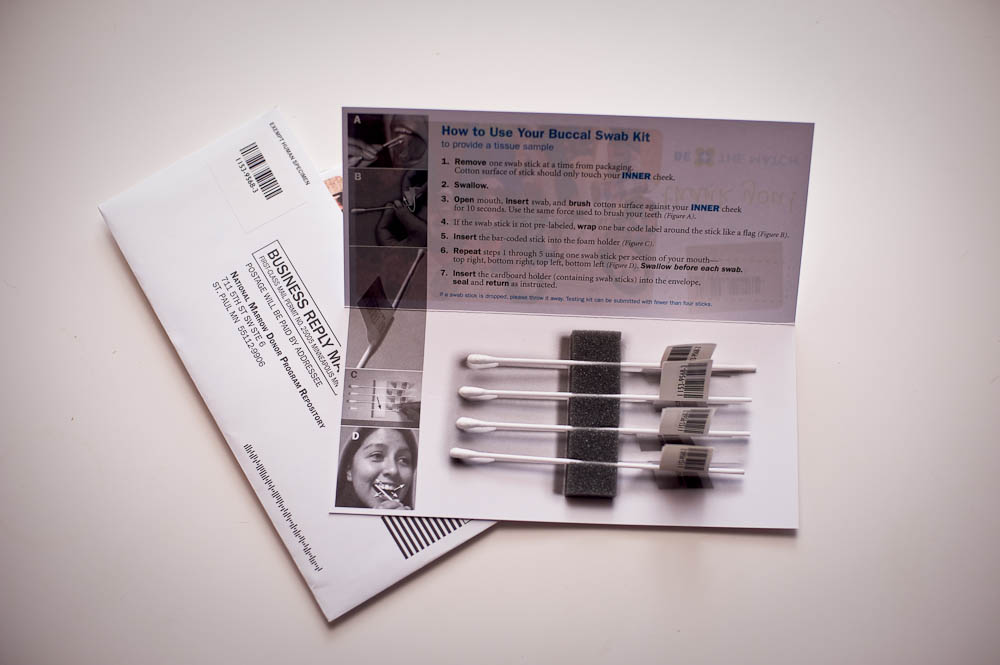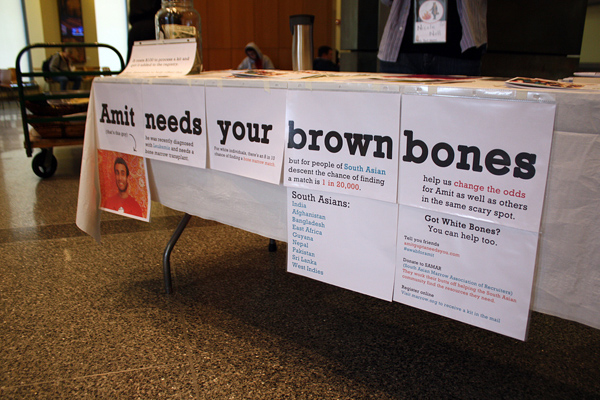 The countdown clock ticks down ominously on www.amitguptaneedsyou.com, counting down the 22 days left of finding a perfect donor bone marrow match for Amit Gupta, who I blogged about before. The bounty for a match (just a certified match, not a donor) is up to $30,000 generously donated by his friends. Amit has now been interviewed on CNN by Sanjay Gupta and his campaign is gaining national traction, with a bone marrow sign up table at almost every Brown event.
The countdown clock ticks down ominously on www.amitguptaneedsyou.com, counting down the 22 days left of finding a perfect donor bone marrow match for Amit Gupta, who I blogged about before. The bounty for a match (just a certified match, not a donor) is up to $30,000 generously donated by his friends. Amit has now been interviewed on CNN by Sanjay Gupta and his campaign is gaining national traction, with a bone marrow sign up table at almost every Brown event.
It’s surprising to me after all this time that there are still people not registered in the bone marrow registry. At last week’s San Francisco Subcontinental Drift, I eagerly convinced my friend to sign up to the bone marrow registry at the back table, surprised that he hadn’t done so already. “I’ve been in the registry for 7 years,” I told him. “All it takes is 4 simple cheek swabs and you are in.” Within minutes, he was in the registry too.
But what is it like to actually donate? That I didn’t have experience in. I do know that if I ever get the chance to donate, I’ll be 99.9% willing to step up to the call of duty. I decided to interview two South Asian American women who had the opportunity to donate bone marrow, Kristeen Singh and Darshana Vakharia. Here’s what they have to say:
Congratulations! When did you do it and what was the overall experience like?
Kristeen: Almost a year ago (Dec 14, 2010), I donated bone marrow for a seventeen year old boy with Leukemia. I was told that the recipient was the same age as my nephew, so it was natural I wanted the same for this boy. As a donor it feels like yes, we are doing it, and yes we are life savers.
Darshana: I donated in January 2004. When I donated all I knew was that it was for a little girl who was 9 years old. My oldest daughter was exactly the same age at that time. Needless to say I couldn’t do the procedure fast enough. All I remember right now is how lucky I felt that I was a match and was actually donating.
When you got the call that you were a bone marrow match, what was your decision making process?
Kristeen: I was in disbelief that I was actually called. It wasn’t until I had my blood tested that confirmed I was the best match that, I believed it. I was excited that during the holiday season, I would get to share the gift of life.
Darshana: The decision was already made for me when I registered to be a donor in ‘92 . However I had to figure out the logistics of dropping off and picking up my girls to and from school who were 9 and 6 at that time. City of Hope was a big help. They sent a Limousine to pick me up, (which was pretty cool) so that my husband could drop off the girls and then come to the hospital. And I wasn’t scared. I Just prayed that the patient was strong enough to receive the marrow and that the transplant would be a success.
Do you know the person that you gave bone marrow to?
Kristeen: I hope to one day find out. I know it is a 17 year old boy that lives in another country. After one year, if both parties agree, you can connect. Either way, I know that part of me is with him always and forever.
Darshana: No. Privacy is a big issue. Both parties have to sign consent forms agreeing to do the procedure. On the form itself only the sex and the age of the patient are mentioned. Also you are counseled about the procedure and they prepare you to face the consequence that, sometimes, in spite of everything, the patient might not make it. City of Hope calls to let the donor know , after a couple of weeks, whether the patient is doing well or not.
How long were you in the hospital for? How long did it take before you fully recovered?
Kristeen: I had a choice of either doing the PBSC or marrow procedure. 70 percent donate using PBSC, but I decided on the marrow procedure. I felt soreness in my lower back, but I can’t even imagine what pain the patient was going through. It was pretty cool that at the end they took my marrow and it was taken to be infused in the patient.
Darshana: I was supposed to be discharged the same day but my blood pressure was a little low and I had to stay an additional day. However, normally you are discharged the same day.
Truthfully, how much pain were you in?
Darshana: Like Kristeen said, I too was sore for a few days and was advised by the doctor to keep walking and that would alleviate the soreness. Frankly, if you’ve had children, then this feels like a sprained ankle 🙂
Did you have health insurance? Who covered the cost?
Darshana: I do have health insurance but I was not responsible for any of the costs, of the procedure itself, the preceding tests or the after care.
How did you initially get listed in the bone marrow registry?
Darshana: I initially got involved with Asians for Miracle Marrow Matches because my best friend’s cousin was suffering from Leukemia. We had a drive for her at my place, where we registered almost 25 -30 people including myself. While we were registering people at my home, my friend called to say that her cousin passed away. They did find her a match but that person lost his nerve at the end and did not agree to donate. I mention this only to point out that if a person is not sure whether he/she wants to go through with the procedure he/she has a choice right until the very end, before they give you anesthesia (as in my case of a marrow procedure). I have volunteered with A3M since that day in my house until the last couple of years.
Would you do it again?
Kristeen: Absolutely
Darshana: In a heartbeat.
Kristeen, you used to work to encourage South Asians to join the bone marrow registry as the South Asian Outreach Coordinator with Asians for Miracle Marrow Matches (A3M) a few years ago. I felt that it was somewhat serendipitous that you were asked to be a donor. What was that like?
Kristeen: It was a wonderful irony that I was contacted to donate. In ’06, I got hired and the first thing I did was register. In September of 2010 I was contacted by A3M and told I was a match. Registering South Asians from all religions between the ages of 18-60 has brought people together to save lives. Those I met and connected with, and the many thousands that registered to save lives, give me faith in the power of community.
Kristeen, you were working with A3M when the Save Vinay & Sameer campaigns happened. Later in a blog you stated that 24,611 people registered in the 3 month span of the campaign, and that 266 were matches. How do you think the campaign was able to be so successful?
Kristeen: Those numbers are from the book Dragon Fly Effect. The campaign was led by Prit Radhakrishnan, Vinay’s good friend. In the beginning Vinays friends, family, and community, all come together to start this campaign. His family and Radhakrishnan launched “Team Vinay” with the goal to register 20,000 people of South Asian descent as fast as possible. Some time later Robert Chatwani, one of Sameer‟s friends mobilized “Team Sameer.” The two teams joined and a power team was created.
In Southern California I was working with Vinay’s family mostly. There was definitely a lot of project management, marketing, logistics, and planning. All the recruiters and staff from A3M were on board and all really helped. I have never worked so hard at anything in my life. You really can’t stop because someones life is at stake. I feel like the main reason people registered was the story and messaging that both teams created. They did a great job of sharing the story so that everyone could see themselves connected to Vinay or Sameer. People felt that Vinay for example could easily be their brother, husband, son or father. People made Vinay and Sameer’s cause their cause.There were tons of dedicated volunteers and every temple, mosque, gurdwara, south asian fraternity, business group, organization came together. In Southern California we were able to register 5000 people.
When I was at the hospital donating my marrow, I was informed that many more South Asians are coming up as matches at that hospital than before and are moving forward. That makes me feel good.
Why do you think it’s important that South Asian Americans join the bone marrow registry?
Kristeen: Because you can save people like Amit Gupta. Also, if someone you know or your family needs a match, this registry will be there for you too. Every year many South Asian patients are diagnosed with blood-related diseases. In order to survive, patients need a bone marrow transplant from a matching donor. Nearly 30% of patients will find a matching donor within their families. The remaining 70% must search for an unrelated donor. Unfortunately, a very small percentage of South Asians (Indians, Pakistanis, Sri Lankans and Bangladeshis) are registered to be marrow donors. South Asians comprise approximately only 2% of the National Marrow Donor Registry.
What kind of illnesses require a bone marrow transplant?
Kristeen: The following diseases are the ones that most commonly benefit from bone marrow transplantation: leukemias; severe aplastic anemia; lymphomas; and immune deficiency disorders. However, patients experience diseases differently, and bone marrow transplantation may not be appropriate for everyone who suffers from these diseases.
Darshana, I know that you have been in touch with who you donated to. Have you been able to stay in touch with them?
Darshana: Unfortunately not. We are facebook friends 🙂 but I felt that it should be their choice if they’d like to keep in touch. They know where to find me.
 What would you tell someone who isn’t listed in the bone marrow registry yet?
What would you tell someone who isn’t listed in the bone marrow registry yet?
Darshana: Technology has made it so that it’s become very easy to be able to save a person’s life. The new procedure is almost painless and all it takes is a few hours out of your life. The marrow you donate is replenished in your system within a matter of weeks. And most important of all is that you have a choice until the very end, but if you do decide to register make an informed and educated decision.
How can people join the registry if they haven’t yet?
Kristeen: Registering is easy and all you need is four cotton swabs with saliva samples and a completed form. You can get a kit mailed home to you or register in person at a drive near you!
Thanks to Darshana and Kristeen for taking the time to answer these questions. I hope that you have gained a little insight into what it means to be a bone marrow donor. If you still need some more information, be sure to check out SAMAR and A3M or this handy FAQ. And of course, to help out Amit Gupta, please visit his site here.

I finally filled out the forms and sent away for the kit last week because these posts and all the tweets have been nagging on my conscience. (My FIL died of leukemia, so I should have ALREADY been on it, but I’m a big chicken. No pun intended.) Good for everyone for continuing to post! I even convinced my needle-phobic husband to do it.
I signed up during that last major drive and was called up about 2 years ago when I turned out to be a match for someone… went through the blood tests etc… and then was told the potential recipient was no longer in a position to receive the transplant. Haven’t been a match for anyone else yet.
What struck me as odd though, was that while I never thought twice when I was told I was a match, every person I ran across (medical professionals I had to interact with in the process of being further tested) seemed surprised that I was willing to go through with the donation. I was constantly being asked about whether I was sure about donating to a stranger… what about the pain etc… I mean, I hadn’t even thought my pain should factor into such a decision… and here I was being questioned about it…
Is cord blood of any use here? Could it be another source of potential donors if more women donated it to a public bank?
Pingback: Genomic databases: making tissue matching drives irrelevant? | Gene Expression | Discover Magazine
Pingback: Genomic databases: making tissue matching drives irrelevant? | Biology News by Biologged
When Sepia Mutiny first came out with this story, I tried to sign up. The operative word being tried because I learnt then that I’m not allowed to donate because I have Psoriasis. I’m not a doctor so I might not have all the facts, but it seems to me that someone would rather have bad skin than be dead.
Pingback: Aziz wants you to give a spit « Lakshmi Gandhi's Blog